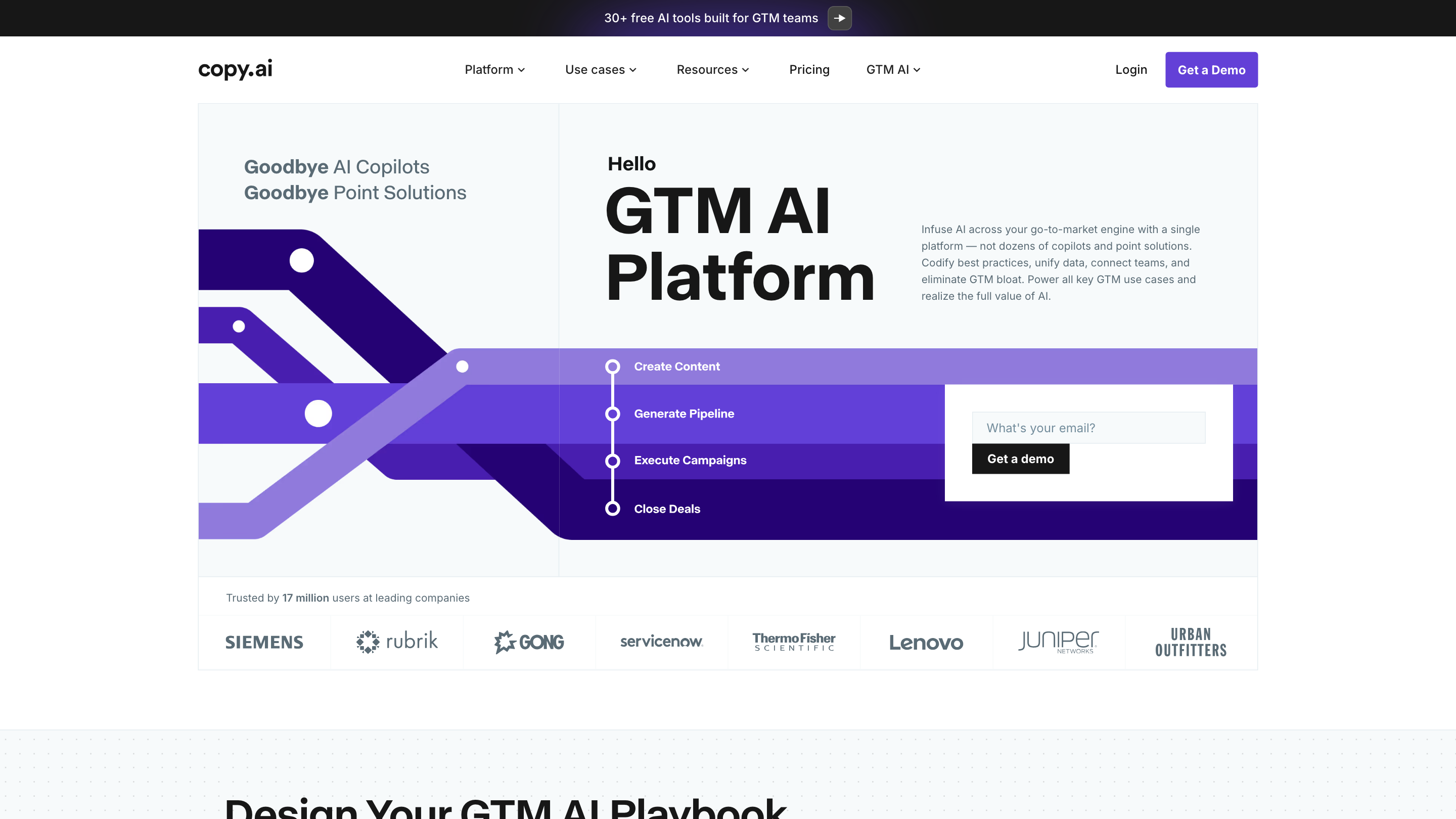Copy.ai
Open siteMarketing & Advertising
Introduction
Copy.ai is an AI-powered tool that simplifies marketing by generating high-quality content.
Copy.ai Product Information
GTM AI Platform Overview
GTM AI is a unified, purpose-built platform designed for go-to-market (GTM) teams to accelerate and scale AI-driven workflows. It combines data, workflows, and AI capabilities to streamline sales, marketing, operations, and enablement across the entire GTM engine. The platform emphasizes eliminating GTM bloat by providing a single, integrated solution with guardrails, templates, and cross-team collaboration.
How it Works
- Centralized playbooks translate GTM strategies into repeatable, automatable workflows.
- AI copilots and agents execute targeted tasks with built-in guardrails and governance.
- Data is unified via tables and an intelligence layer to power accurate AI outputs.
- Brand voice and content guidelines ensure consistent messaging across channels.
- Integrations (2,000+ connectors) connect disparate systems to the GTM workflow.
Platform Components
- Actions: Building blocks to harness AI without requiring advanced AI expertise.
- Agents: Automate targeted tasks with AI decision-making and guardrails.
- Tables: A queryable data foundation that consolidates sources for AI automation.
- Chat: A prompting interface for rapid one-off tasks and to-dos.
- Infobase: Centralized repository of company information to inform content generation.
- Brand Voice: Definition of your brand’s personality to ensure authentic outputs.
- 2,000+ Integrations: Broad connectivity across tools and data sources.
- LLM Model Agnostic: Works with multiple large language models.
- For every page in your playbook, there’s a workflow for that.
Key Platform Concepts
- Workflows: AI-powered codifications of processes, plays, and best practices that unify teams and systems.
- Copy Agents: Intelligent automation to support GTM tasks.
- Intelligence Layer: Centralized reasoning to drive decision-making.
- Tables: Unified data store powering AI automation.
- Infobase: Central knowledge repository for content generation.
- Brand Voice: Consistent tone and style across outputs.
- Chat: Interactive interface for quick tasks and prompts.
Use Cases
- Sales Prospecting Cockpit: Deep research accounts and contacts to craft high-quality outreach.
- Inbound Lead Processing: Automatically enrich, research, and engage marketing-generated leads.
- Account Based Marketing: Insights on accounts, industries, and personas; AI-generated assets at scale.
- Content Creation: AI-powered content engine for SEO, thought leadership, social, and more.
- Translation & Localization: Real-time, native-level translations across languages.
- Deal Coaching & Forecasting: AI-driven insights from transcripts; scoring, strategy suggestions, and close date predictions.
- Operations: Lead + Account Intelligence; CRM Enrichment; system integrations.
How to Use GTM AI
- Define your GTM playbook and workflows aligned to your goals.
- Connect your data sources via Tables and Integrations.
- Use Copy Agents and Actions to automate tasks and decisions.
- Leverage Infobase and Brand Voice to produce consistent content and outputs.
- Monitor results and iterate on workflows for continuous improvement.
Safety & Governance
- Guardrails and governance are baked into agents to prevent undesirable actions.
- SOC 2 compliance and security considerations protect data within automated GTM workflows.
Pricing & Support
- Pricing tiers and enterprise options are available; contact sales for a demo.
- Help Center, Changelog, and Technical Resources provide ongoing support and documentation.
Core Features
- Unified GTM AI platform replacing multiple point solutions
- AI-powered Workflows to codify GTM plays and best practices
- Actions to enable AI-driven tasks without AI expertise
- Agents for automated task execution with guardrails
- Tables as a unified data foundation powering AI automation
- Infobase for centralized information to inform content generation
- Brand Voice to ensure consistent, authentic content outputs
- 2,000+ Integrations for broad data connectivity
- LLM-agnostic architecture for flexible model use
- Platform designed to reduce GTM bloat and accelerate velocity
